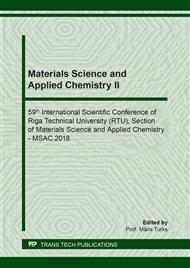[1]
V. Bobade, N. Eshtiaghi, Heavy metals removal from wastewater by adsorption process: A review, Asia Pacific Confederation of Chemical Engineering Congress 2015 (APCChE 2015), Melbourne, Australia, 27 September-1 October 2015, 312-317.
Google Scholar
[2]
Z. Elouear, J. Bouzid, N. Boujelben, Removal of nickel and cadmium from aqueous solutions by sewage sludge ash: study in single and binary systems, Daniel Thevenot, World Wide Workshop for Young Environmental Scientists: 2010, May 2010, Arcueil, France.
DOI: 10.1080/09593330902824940
Google Scholar
[3]
R.W. Schneiter, E.J. Middlebrooks, R. Sletten, Wastewater lagoon sludge characteristics, Water ResearchVolume. 18(7) (1984) 861-864.
DOI: 10.1016/0043-1354(84)90270-7
Google Scholar
[4]
D.W. Hamilton, Sludge accumulation in two anaerobic/facultative lagoons treating swine manure from breeding farms in Oklahoma, American Society of Agricultural and Biological Engineers. 53(2) (2010) 529-536.
DOI: 10.13031/2013.29567
Google Scholar
[5]
Z. Ezzeddine et al, Divalent heavy metals adsorption onto different types of EDTA-modified mesoporous materials: effectiveness and complexation rate, Microporous and Mesoporous Materials. 212 (2015) 125-136.
DOI: 10.1016/j.micromeso.2015.03.013
Google Scholar
[6]
R. Balasubramanian, S.V. Perumal, K. Vijayaraghavan, Equilibrium isotherm studies for the multicomponent adsorption of lead, zinc, and cadmium onto Indonesian peat, Ind Eng Chem Res. 48 (2009) 2093-2099.
DOI: 10.1021/ie801022p
Google Scholar
[7]
V.K. Gupta, I. Ali, Removal of lead and chromium from wastewater using bagasse fly ash- A sugar industry waste, J Colloid Interface Sci. 271 (2004) 321-328.
DOI: 10.1016/j.jcis.2003.11.007
Google Scholar
[8]
R. Rak, M. Kashifuddin, Kinetics and isotherm studies of Cd(II) adsorption from aqueous solution utilizing seeds of bottlebrush plant (Callistemon chisholmii), App Water Sci. 4 (2014) 371-383.
DOI: 10.1007/s13201-014-0153-2
Google Scholar
[9]
A. Nayak, B. Bhushan, V. Gupta, P. Sharma, Chemically activated carbon fromlignocellulosic wastes for heavy metal wastewater remediation: effect of activation conditions, Journal of Colloid and Interface Science. (2017).
DOI: 10.1016/j.jcis.2017.01.031
Google Scholar
[10]
S. Benhammadi et al, Adsorption of lead(II) in liquid-solid interfaces on natural and modified hydroxyapatite, Key Eng. Mater. 721 (2016) 117-122.
DOI: 10.4028/www.scientific.net/kem.721.117
Google Scholar
[11]
C. Liu, X. Lu, M. He, E. Jan Meijer, R. Wang, Surface complexation of heavy metal cations on clay edges: insights from first principles molecular dynamics simulation of Ni(II), Geochimica et Cosmochimica Acta. (2017).
DOI: 10.1016/j.gca.2017.01.014
Google Scholar
[12]
A. Iddou, Y. Mohamed, A. Abdellah, M.S. Ouali, Biosorptive removal of lead(II) ions from aqueoussolutions using Cystoseira stricta biomass: study of thesurface modification effect, Journal of Saudi Chemical Society. 15 (2011) 83-88.
DOI: 10.1016/j.jscs.2010.10.007
Google Scholar
[13]
A. Jouraiphy, S. Amir, M. El Gharous, J.C. Revel, M. Hafidi, Chemical and spectroscopic analysis of organic matter transformation during composting of sewage sludge and green plant waste, Int. Biodeterior. Biodegrad. 56 (2005) 101-108.
DOI: 10.1016/j.ibiod.2005.06.002
Google Scholar
[14]
T. Cui, Z. Li, S. Wang, Effects of in-situ straw decomposition on composition of humus and structure of humic acid at different soil depths, J. Soils Sediments. 17 (2017) 2391-2399.
DOI: 10.1007/s11368-017-1704-6
Google Scholar
[15]
B. Manohara, S.L. Belagali, Characterization of essential nutrients and heavy metals during municipal solid waste, Int. J. Innov. Res. Sci. Eng. Technol. 3 (2014) 9664-9672.
Google Scholar
[16]
S. Amir, M. Hafidi, G. Merlina, J.C. Revel, Structural characterization of fulvic acids during composting of sewage sludge, Process Biochem. 40 (2005) 1693-1700.
DOI: 10.1016/j.procbio.2004.06.037
Google Scholar
[17]
X. Zhang, C. Sun, L. Zhang, H. Liu, B. Cao, L. Liu and W. Gong, Adsorption studies of cadmium onto magnetic Fe3O4·FePO4 and its preconcentration with detection by electrothermal atomic absorption spectrometry, Talanta. 181 (2018) 352-358.
DOI: 10.1016/j.talanta.2018.01.023
Google Scholar
[18]
P. Sipos, T. Németh, V. Kovács-Kis, I. Mohai, Sorption of copper, zinc and lead on soil mineral phases, Chemosphere. 73 (2008) 461-469.
DOI: 10.1016/j.chemosphere.2008.06.046
Google Scholar
[19]
Y.S. Ho, G. McKay, Pseudo-second order model for sorption processes, Process Biochem. 34 (1999) 451-465.
DOI: 10.1016/s0032-9592(98)00112-5
Google Scholar
[20]
I. Langmuir, The adsorption of gases on plane surfaces of glass, mica and platinum, Journal of the American Chemical Society. 40 (1918) 1361-1403.
DOI: 10.1021/ja02242a004
Google Scholar
[21]
H.M.F. Freundlich, Over the adsorption in solution, Journal of Physical Chemistry. 57 (1906) 385-470.
Google Scholar


